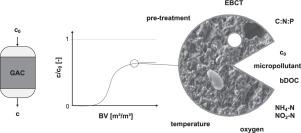Water Research ( IF 11.4 ) Pub Date : 2020-11-07 , DOI: 10.1016/j.watres.2020.116588 T. Fundneider , V. Acevedo Alonso , A. Wick , D. Albrecht , S. Lackner

|
Granulated Activated Carbon (GAC) filtration is a common process for advanced wastewater treatment. In such filters, the removal of organic substances results from adsorptive as well as biological processes. This work investigated the potential of biological processes and their influence on GAC-filter performance. During 32 months, the removal of micropollutants,Dissolved Organic Carbon (DOC) and the spectral absorption coefficient was monitored in six GAC-filters. The effects of pre-treatment (cloth- and/or membrane-filtration), EBCT (from 6 – 35 min) and GAC-type were evaluated. Likewise, the impact of the influent´s fluctuations in temperature, flow and concentration (ammonia, nitrate, and soluble reactive phosphorus (sRP)) were analysed. Biological processes were tracked by the frequency of backwashing, oxygen consumption, removal of poorly absorbable micropollutants and production of transformation products. Pre-treatment influenced biofilm growth significantly. Membrane filtration delayed the first backwashing event by 122 d in comparison to cloth-filtration, where the first backwash was conducted after only 21 d. Removal of poorly absorbable substances was observed early on (40 – 50 d). Parallel operation contributed to a better utilisation of the GAC-capacity and the biological removal potential. Influent nitrogen species > 0.5 mg N/L promoted biofilm growth, whereas sRP seemed to have no effect. The developed biofilm and optimal operating conditions led to longer life spans of the GAC-filters, making carbon usage rates comparable to those from PAC applications. The results suggest that biological processes accounted for about 25 – 42% of the totally removed DOC at the end of the operation.
中文翻译:

生物活性炭滤池对废水中微污染物去除的意义
颗粒活性炭(GAC)过滤是用于高级废水处理的常用方法。在这种过滤器中,有机物的去除是由于吸附过程和生物过程引起的。这项工作调查了生物过程的潜力及其对GAC过滤器性能的影响。在32个月中,在六个GAC过滤器中监测了微污染物,溶解有机碳(DOC)的去除和光谱吸收系数。评估了预处理(布过滤和/或膜过滤),EBCT(6-35分钟)和GAC型的效果。同样,分析了进水温度,流量和浓度(氨,硝酸盐和可溶性反应性磷(sRP))波动的影响。通过反冲洗的频率,耗氧量,去除吸收性差的微污染物并生产转化产物。预处理显着影响生物膜的生长。与布过滤相比,膜过滤将首次反洗事件延迟了122 d,而布过滤仅在21 d后进行。在早期(40 – 50 d)观察到去除了吸收性差的物质。并行操作有助于更好地利用GAC容量和生物去除潜力。进水氮> 0.5 mg N / L促进了生物膜的生长,而sRP似乎没有作用。先进的生物膜和最佳的运行条件使GAC过滤器的使用寿命更长,从而使碳的使用率可与PAC应用相比。











































 京公网安备 11010802027423号
京公网安备 11010802027423号